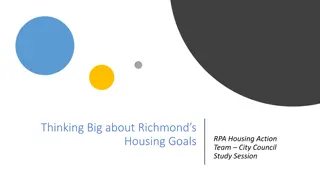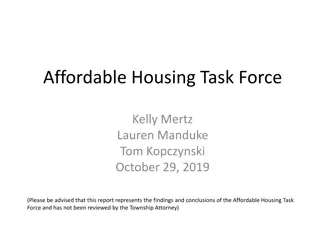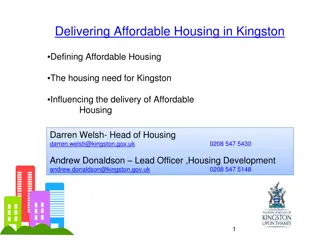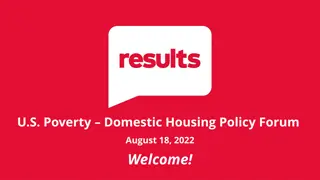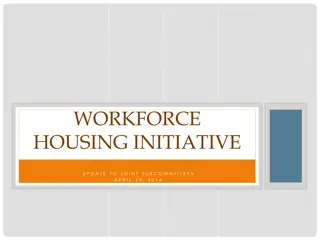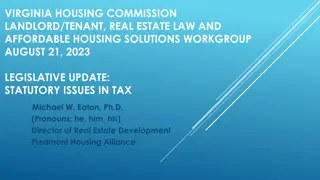Overview of Oregon Affordable Housing Tax Credit Program
The Oregon Affordable Housing Tax Credit (OAHTC) Program was established in 1989 by the Oregon Legislature, enabling lending institutions to claim tax credits against Oregon taxes for affordable housing projects. Recent rule changes and proposed revisions, such as HB 2315, impact how tax credits are calculated and passed on to tenants. Compliance updates and uniform calculation sheets are being implemented to streamline processes. The program aims to support affordable housing initiatives and benefit project tenants through reduced rents.
Download Presentation

Please find below an Image/Link to download the presentation.
The content on the website is provided AS IS for your information and personal use only. It may not be sold, licensed, or shared on other websites without obtaining consent from the author. Download presentation by click this link. If you encounter any issues during the download, it is possible that the publisher has removed the file from their server.
E N D
Presentation Transcript
OAHTC-New Rules and Processes Oregon Opportunity Network Spring Industry Support Conference- April 18, 2017 Presented by: Teresa Pumala, OHCS Jake Kirsch, NOAH Jennifer Marchand, OHCS
Agenda Welcome and Panel Introductions Brief OAHTC Program Overview HB 2315 and Need for Change OHCS Information and Tips NOAH Information and Tips Compliance Information Compliance FAQ s Audience Questions* *Please feel free to ask questions during presentation
Program Overview In 1989 the Oregon Legislature created the Oregon Affordable Housing Tax Credit (OAHTC) Program which enables a lending institution to claim Oregon Affordable Housing Tax Credits against Oregon taxes with respect to loans for the construction or acquisition, and rehabilitation of affordable housing projects. In exchange for this tax credit, project tenants get lower rents for each dollar of credit taken by the bank with 2 exceptions: 1. Preservation of Manufactured Home Parks 2. Preservation of projects at risk of losing existing federal rental subsidies
Rule Change On March 24, 2015 OHCS announced adoption of temporary rule 813-110 Oregon Affordable Housing Tax Credits (OAHTC). This rule became permanent November, 1, 2015. The rule change impacted the way OAHTC pass-through can be calculated when being applied to units with tenant-based Section 8 or Housing Choice Vouchers.
HB 2315 OHCS is now proposing a revision to ORS 813-110 in order to remove existing language that conflicts with the new rule. Currently Section (5)(b)(ii) states, full amount of savings from the reduced interest rate provided by the lending institution is or will be passed on to the tenants in the form of reduced housing payments, regardless of other subsidies provided to the housing project. If passed, HB 2315 will allow OHCS to remove the conflicting language within the current rule and get more specific on how to calculate pass-through including using tenant-based voucher units. OHCS compliance will institute a new uniform calculation sheet to aid management agents managing pass-through requirements. Update: HB 2315 passed the Senate on 5-31-2017
NOFA Application 0 Project Name: 4.1C: Questionnaire Preferences (10 points) 1a- Serving Lowest Incomes; Average Gross Median Income (5 points) Populate the table below based on the LIHTC restrictions that will be placed on the units. # Total Units 30% Units 40% Units 50% Units 60% Units 60% Units 80% Units 90% Units 100% Units % of Units 0% 0% 0% 0% 0% 0% 0% 0% %*Inc.% 0% 0% 0% 0% 0% 0% 0% 0% AGMI 0% must = 100% 0% high/low income Select County: Baker Low % of total units county high/low - - - if scattered sites in different counties, list: if scattered sites in different counties, list: if scattered sites in different counties, list:
Pro forma Income Gross Monthly Rent Per Unit Tenant Paid Utility Allow Unit Type (BDR /MGR) Afford- able vs Market Square Feet / Unit Median Income % - - - - - - - - - - - - - - - Unit Size # of Baths Project site: - - - - - - - - - - - - - - - add more units by unhiding rows Tot Res SqFt 0 Aff Sq Ft 0 Market SqFt 0 select site: Subsidy:
Pro forma OAHTC Calculation OAHTC RENT REDUCTION CALCULATION OAHTC Payment Calculated Monthly 0 1/0/1900 Project Name: Date: Initial Application Pro Forma Type: WITH OAHTC $1,000,000 1.00% 30 $3,216.40 20 4.0% $554,234 40 $58 $27,840 W/O OAHTC $1,000,000 5.00% 30 $5,368.22 Loan amount: Interest rate: Number of years to amortize: Monthly payment amount: Number of years tax credits taken: Interest rate reduction: interest rate reduction could be 4% or less Total tax credit allowed: Number of units: Rent reduction unit/month: Annual rent pass through: number of units using OAHTC Required OAHTC Annual Pass Through Actual OAHTC Annual Pass Through Amount over/under required pass through $58 $125 $67 $27,840 $60,000 $32,160 If a positive number, then pass through is sufficient. LOAN AMORTIZATION MAXIMUM ANNUAL TAX CREDIT ENDING BALANCE $971,272 $942,255 $912,947 $883,344 $853,444 $823,243 PRINCIPAL REDUCTION $28,728 $29,017 $29,308 $29,603 $29,900 $30,200 AVERAGE INTEREST $9,869 $9,580 $9,288 $8,994 $8,697 $8,396 AVERAGE BALANCE $984,463 $955,578 $926,404 $896,936 $867,173 $837,110 TAX CREDIT $39,379 $38,223 $37,056 $35,877 $34,687 $33,484 YEAR 1 2 3 4 5 6 INTEREST $9,869 $9,580 $9,288 $8,994 $8,697 $8,396 PRINCIPAL $28,728 $29,017 $29,308 $29,603 $29,900 $30,200 YEAR 1 2 3 4 5 6
OAHTC Declaration Rent Limits. Owner will, throughout the Affordability Period described below, restrict rents for such Qualified Units to limits established herein, including applicable Program Requirements. Owner will further restrict rents in the Project beyond what is described in the table below reflecting other applicable OHCS subsidy restrictions and in a manner consistent with other applicable OHCS subsidy requirements, including federal low-income housing tax credit requirements. Further rent restrictions will be consistent with the Rent Pass-Through requirements found in section 3(d). Unit Type Number of Units Income As Determined by HUD 1 Bedroom 2 Bedroom 3 Bedroom Manager (# bdr) enter N/A * (d) Rent Pass-Through. The Rent Pass-Through per month per unit to Qualified Units without Project-based vouchers, in order to accomplish the identified Rent Reduction mandated above, will be an average amount of dollar amount of average per unit pass-through required longhand ($##), with the combination of all monthly Rent Pass Through to the Qualified Units in the Project will total on an annual basis an amount not less than dollar amount of total annual pass-through required longhand ($##). Maximum Percent of Median Family Maximum Rent Standards As Determined by HUD ## % # ##% # ##% ##% # ##% ##% # If restricted enter %; if not restricted If restricted enter %; if not restricted enter N/A
o Mission-driven lender established in 1990 o 209 perm loans totaling approximately $253 million o Approximately 75% involved OAHTC s o 157 loans totaling approximately $188 million including $154 million in OAHTC o Represents large portion of OHCS non-bond OAHTC allocations
o Can provide significant technical assistance o Help refine pro forma for application o Review OAHTC declaration o Review & accept OAHTC certification o Help troubleshoot compliance issues o Requires monthly escrow deposits for OAHTC compliance fee oCalculates & pays fee to OHCS annually
o Avoiding pass-through pitfalls: o Use pre-OAHTC rent levels in the Preferences grid in the OHCS LIHTC Questionnaire o Section 4.1C of 2016 NOFA application o Project-based voucher units not eligible o Evenly spread rent reduction over eligible units or prepare partners for possible adjustments during compliance period
o Avoiding pass-through pitfalls continued: o Know your starting point o Only rent restrictions from OHCS funds apply (LIHTC, GHAP, state funded HOME, etc.) o Locate your regulatory agreements & make a grid o Contact OHCS prior to adding project-based vouchers after funding
OHCS OAHTC Compliance Goal of OHCS Compliance: 1) To determine if the tenants are receiving the benefit of the full amount of the rent reduction that was agreed to when the interest savings was received by Owner as indicated in the OAHTC declaration. 2) To educate partners on OAHTC requirements and rent reduction obligations. Example taken from actual LURA: SECTION 5 RENT REDUCTION The Owner represents, warrants and covenants that, throughout the term of this Declaration; (a) The Owner shall be in compliance with the rent limitations established in the OAHTC Administrative Rules (813-110) and, when applicable, the rent limitations established pursuant to IRC Section 42 by ensuring that: (b) Rents in the project will be reduced annually by a total of at least $37,597. This Rent Reduction is calculated from the Rents Charged at the Market Interest Rate indicated in the OAHTC application dated February 6, 1998. Such rents may be adjusted annually based on the percentage increase in the area median gross income where the Project is located as announced by the Department of Housing and Urban Development. In no event, shall rents be required to decrease as a result of such adjustment below the rates shown in the application. (c) The Rent Pass Through per month per unit to the tenant, in order to accomplish the Rent Reduction mandated in (b) above will be an average amount of $65.00, with the combination of all monthly Rent Pass Through to the tenants in the project on an annual basis totaling not less than $37,597.
Reporting Requirements Certifications of Continuing Program Compliance (CCPC s) must be submitted once annually by the end of February for the previous calendar year for every OHCS funding source. For example CCPC s documenting compliance for the period of January 01 to December 31, 2016 were due by February 28, 2017. Each funding source certification is designed to request information or documentation to support compliance requirements.
Reporting Continued Demonstration of rent reduction pass through is also required to be submitted: 1) During the process of any OHCS scheduled compliance inspection (ideally once every three years-may be more) 2) When the property requests a rent increase 3) Any other time as requested by OHCS as needed
Exemptions Certain properties are exempt from meeting OAHTC rent reduction pass through 1) Manufactured Dwelling parks 2) Preservation Projects OAR 813-110-0015 (b) In the case of a preservation project or a manufactured dwelling park awarded after September 27, 2007, pass-through is not required for a certification produced on or after September 27, 2007. Preservation project means housing that was previously developed as affordable housing with a contract for rental assistance from the United States Department of Housing and Urban Development or the United States Department of Agriculture and that is being acquired by a sponsoring entity. The contract for project-based rental assistance must cover at least 25 percent of all units in the project.
Calculating OAHTC How to calculate: The estimated annual average per-unit pass through for the project is to be calculated by dividing the annual loan interest savings, divided by twelve months, and then by dividing the number of affordable units occupied or held vacant for occupancy by qualified tenants. Where to start: The OAHTC program is intended to lower rents below the level that would be obtained after all other subsidies have been applied. When a project uses one or more other department (OHCS) programs the OAHTC reduction should be calculated by deducting the rent reduction from the other programs restricted rent obligation. Funding from non-OHCS sources: Only rent restrictions from OHCS funds apply (LIHTC, GHAP, state funded HOME, etc.) when determining a start point for the reduction.
Calculating With Vouchers Project Based Vouchers: Some projects that have PBV funding are exempt from passing on a rent reduction, however many are not. 813-110-0015 (4) Rental units covered by Section 8 project based assistance are not eligible to be used to demonstrate pass-through savings for the OAHTC program because the rent reductions related to the OAHTC subsidy typically would not be passed on to the tenants in the form of a rent reduction from what the tenants would otherwise pay, and therefore, would not achieve pass-through savings. Projects that are partially covered with project based assistance may qualify to use OAHTC on the remaining units by, inter alia, demonstrating pass- through interest savings that result in appropriate rent reductions to the OAHTC qualified tenants. To the degree this can be achieved in conjunction with tenant vouchers not targeted for pass through, it is encouraged to be targeted to non-voucher units in the Project.
Calculating With Vouchers Important Tip: To find out if the property you Own/Manage is exempt from pass through requirements ask the Owner first and then call the OHCS Compliance officer for more information. Before adding Project based assistance to an existing property with OAHTC it is VERY IMPORTANT that you notify OHCS. OHCS staff can walk you through the property s specific funding requirements and help you identify any barriers. For example how to meet rent reduction requirements and/or keep the HOME mix in compliance.
Calculating Vouchers Continued Housing Choice or Tenant Based Vouchers: Pass through is limited for units occupied by a tenant with a tenant based Section 8 or Housing Choice Voucher, under 813-110-0013(2)(C). Project owners may only assign up to the maximum of the estimated annual average per-unit pass through to units whose qualified tenants are using a tenant based Section 8, or Housing Choice Voucher .
HCV Calculation Example Maria Smith is a long term tenant of The Spring Apts. The property was developed with LIHTC/OAHTC funding. The Maximum LIHTC rent for the unit that she resides in is $1,000.00 per month. The Owner pays all utilities. The Owner does not charge non-optional fees. Maria recently received a HCV from the local public housing authority. The PHA calculated Maria s tenant portion of rent based on her adjusted income to be $300.00 per month. Per the OAHTC declaration for this property the Owner agreed to an OAHTC rent reduction of $12,000.00 per year averaging to $100.00 per unit per month.
HCV Calculation Continued How would you calculate the annual pass through for Maria s unit? Choose One: 1) I cannot calculate pass through for this unit at all because it is not allowed. She has a voucher. The total is $0. 2) Deduct the total tenant payment of $300 from the max rent of $1,000 and times by 12 (700 X 12 = annual reduction of $8,400.00 for Maria s unit) 3) Calculate the average unit reduction per the OAHTC declaration ($100 X 12 = $1,200.00) Correct Answer: #3
OAHTC Calculation Worksheets Previous version: Lumped Unit types together and was not unit specific. Did not take into account voucher situations. New Improved Version Excel Spreadsheet (provided as handout): Can be found on the OHCS webpage: http://www.oregon.gov/ohcs/Pages/asset-management- resources.aspx Includes unit specific information and area to include HCV
Consequences of Non-Compliance Most non-compliance situations that come to the attention of OHCS appear to be 1) A misunderstanding of OAHTC requirements and/or 2) A lack of communication between Owner/Agent. When non-compliance is discovered the main goal of OHCS Compliance is to 1) Help Owner/Agent get back into compliance and 2) Educate Owner/Agent about program requirements. Most OAHTC non-compliance situations can be satisfied by: 1) Correcting calculations to properly represent the true annual rent reduction of the property 2) Adjust rents as needed 3) Fix the unit reduction mix as needed
Consequences Continued Most Owners/Agents are very willing to address non-compliance situations right away. However, willful refusal to comply with the OAHTC requirements may result in: 1) Interest rate increase for property 2) Lender action as written in lender agreements between lender and Owner General OHCS Consequences of Non-Compliance Examples Include (but are not limited to): The status of Owners, managing agents, and or general partners may be designated as not in good standing with the agency Future approvals for management companies may be denied portfolio wide Required training of staff and/or Change in management or site staff may be required A professional consultant may be required to be hired* Required third party audits for compliance* 100% file and/or physical inspections by OHCS or third party* as required by OHCS Additional OHCS monitoring and/or charging of non-compliance fees Required training of staff* Future applications for housing credits or other funding may be subject to automatic denial *At Owners expense
FAQs Does the rent reduction apply evenly to all units? The OAHTC subsidy must be applied to OAHTC qualified tenants or homeowners in its entirety although the pass-through need not be distributed evenly among the units. Can I calculate a rent reduction for management units that are occupied by staff members? Only if the staff members are qualified low income tenants certified correctly for the program paying a reduced rent. The unit must be an eligible unit per the declaration. The property I manage is 100% @60% but there are additional set- asides of 30%. Does that mean I have to reduce the 30% rents? In some cases, the owner may have agreed to further reduce allowable rents to be utilized for other programs or to meet pass through requirements (for example, 30% rents instead of 60% rents). If this was done, rents may already be lowered enough to accomplish the reduced rent requirements for OAHTC.
FAQs Continued How do I know if the Owner agreed to the lower set-aside (30% units for example) with the intent of meeting the rent reduction requirements? The property pro forma spreadsheet showing rents before OAHTC and after OAHTC is a good resource to use for this purpose. If you need help obtaining documentation ask the Owner and then call your OHCS Compliance Officer. If a resident in a 30% unit receives a voucher and I can no longer meet pass-through requirements what do I do? You can float out the 30% designation or reduce the rents of other in place tenants.
FAQs Continued How do I float out a set-aside designation or choose someone to give a larger reduction to if needed? Maintaining the required number of set-aside units is important to comply with unit mix requirements. When re-designating units in order to maintain the required unit mix, Owners/Agents must substitute a comparable unit. You can choose to substitute a larger unit for a smaller unit. A larger unit is one that might be considered more preferable because of larger size, additional bedrooms, or amenities. This type of substitution is not required. However, Owners/Agents are never permitted to substitute a smaller unit for a larger unit. The process utilized for re-designating set-aside units in order to maintain the correct unit mix must be outlined in the Tenant Selection Plan for the specific property. Be sure the Tenant Selection Plan provides for a consistent and fair method for the re-designation when needed and be sure to regularly follow the plan as outlined. It is recommended to keep supporting documentation to show the plan has been followed, and to keep an updated spreadsheet documenting the unit mix.
FAQs Continued How do I float out a set-aside designation or choose someone to give a larger reduction to if needed (continued)? There are many ways that rents/set-asides can be re-assigned. Examples include: Assigning the lower rent /set-aside to the next household that moves in Assigning the lower rent /set-aside to the existing household that qualifies and has been at the property longest Assigning the lower rent or set-aside to the existing household that has the lowest income Tips: Establish a clear written plan that is reasonable and applied consistently. Communicate and coordinate with the Owner regarding the plan and make sure that all staff members are aware of the plan.
FAQs Continued What are the income and rent limits for OAHTC funding? The Owner is required to pass the benefit of the project's reduced loan interest rate to tenant or homeowner households whose earnings are less than 80 percent of area median income at the time of initial tenant or homeowner qualification (unless exempt). However when paired with other sources, the more restrictive income limit would apply (for example 60% for LIHTC). There are no rent limits established however the rent reduction must be applied to the most restrictive funding source utilized by OHCS and the tenants should not be rent burdened. For example if calculating a rent for an 80% income unit, the rent should be no more than the 80% MTSP Actual year limit as published by HUD for the county where the property is located.
FAQs Continued How long is the compliance period? OAR 813-110-0037 Use of Project; Transfer of Title (1) The sponsoring entity and the owner of a project, including any successors, assigns or transferees shall maintain operate and maintain the project in a manner consistent with program requirements including, but not limited to its use for eligible occupants, for the term of the tax credits or twenty years, whichever is longer. (2) If the title to a project transfers to the lending institution because of a foreclosure, a deed-in-lieu of foreclosure or an involuntary transfer under a bankruptcy proceeding, the lending institution may dispose of the property at its sole discretion. Stat. Auth.: ORS 317.097
Thank you for Attending Jennifer Marchand OHCS Multifamily Program Compliance Technical Advisor 503-986-2031 Jennifer.C.Marchand@Oregon.gov Teresa Pumala OHCS Tax Credit Programs Manager 503-986-2112 Teresa.Pumala@oregon.gov Jake Kirsch NOAH Relationship Manager 503-501-5687 jakek@noah-housing.org











